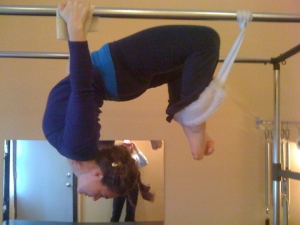Most of Personal Euphoria’s group classes are mixed level, but a couple of our towns offer intermediate classes. People regularly ask me what the differences between beginner and intermediate classes are. So here are some basic guidelines I like to follow:
- Pilates Basic Principles
You know and are familiar with all the basic principles. It doesn’t mean you absolutely have to have perfected each principle, but you know it when you hear it and while you may require a reminder, you can make the adjustment needed if cued to. The general basic principles are: breathing, imprint vs. neutral, shoulder stability, neck placement during exercises, and knitting the ribs. Again, this doesn’t mean that you never need to be reminded to relax your shoulders, but when you hear that reminder you are able to. It doesn’t mean that you never feel an exercise in your neck, but when you do, you have ways to move your body to release that tension or you know to lower the head.
- Control Imprint vs Neutral
This is one of the basic principles, but this one is vital to moving toward more challenging exercises. To be in an intermediate or advanced class, you must not only know the difference, but on every exercise you must be able to stabilize in either. That means if we are supposed to be in neutral you don’t accidently rock to imprint or get pulled further than neutral, arching the back more. Perhaps even more importantly you know your limits on maintaining imprint and you work within them. Part of this one is body control. Part of this one is ego. You may not be able to get your legs as low as someone next to you while holding imprint, but you understand that isn’t the goal. The goal is to move within your range of motion while holding imprint. You know what that range is.
- Modify/Know Your Limits
Without being told you know the modification your body requires. An intermediate class moves at a faster pace, so an instructor may not always cue all the possible modifications. That means you already know that if your back hurts you lower your feet. If your neck hurts you lower your head. If the tension is too much, you drop the band. It’s not just knowing. You choose to modify, making the best choice for your body whenever you need to, even if you normally don’t need to.
- Faster Pace—Familiar with Exercises
While you don’t need to remember each exercise name, having a pretty good concept of what is coming is helpful. We rest less between each exercise and the instructor will probably get down and show less. The class just moves. You can still take breaks as needed, but once we’re off, we’re off and running. In fact, one of the things I don’t really love about a lot of advanced exercises is that there really isn’t time to think about form. You go for it. You kind of do it or you don’t. The exercises can be so challenging, not positions you want to sit and hang out in. Still, these moves can be really beneficial and even feel really good, but if you don’t have great form one day, you aren’t going to do the exercise over and over to get it right. Many of the harder exercises are done three to six times.
- Coordination
You don’t have to be perfect at every exercise the first or the 100th time, but you are up for a challenge of exercises that have more coordination and multiple steps. Some of the more intermediate exercises challenge your coordination.
- Full Roll Up & Teaser
I say this one hesitantly because I have had multiple people who belong in an intermediate class that can’t do the full roll up or teaser. It’s not a deal breaker because there are so many reasons a person can struggle with these exercises. Still, I keep it on the list because in intermediate classes there are even more exercises that build off this movement. If you can’t do the exercise, you might find you are stuck on multiples exercises. That being said, you can do a modification or a different exercise, keep practicing and still attend an intermediate class. Just know most intermediate classes will have the full roll up, teaser and then some.
- Beginner is Still Hard
So this one is a tad complicated because one of the reasons you might be feeling ready to move to an intermediate class is that you feel the exercises in your beginner class have gotten easier. In many ways they should have. You should feel you know them. Hopefully, you can even breathe while doing each exercise. You have improved. You know how to stabilize and turn certain muscles on to make sure you are getting the most out of the exercises. Obviously some exercises are harder than others, but any exercise—whether ab prep, breast stroke prep, or hip rolls—if you are doing them right, should feel like a challenge. No matter what level you are in if you do an exercise and you say, “this feels easy,” know that you are doing something wrong or not connecting somewhere. There is no easy Pilates exercise.
Always talk to your instructor. You may want to watch or try a class before registering.
Want more Personal Euphoria?
Follow the Personal Euphoria Facebook page, follow Personal Euphoria on Instagram, and subscribe to the Personal Euphoria YouTube Channel.

